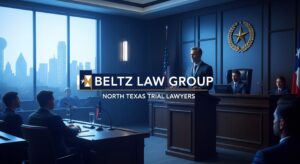Last Updated on July 17, 2025 by Beltz Law Group
Can Illegally Parked Police Lead to Dismissed Traffic Tickets in Texas?

North Texas Trial Attorneys
Understanding Evidence Exclusion in Traffic Cases
Imagine facing a traffic ticket in Texas, and the prosecution has video evidence that seems to undeniably show your guilt. What if that crucial evidence could be thrown out? This article explores a clever, though potentially challenging, legal strategy that defense attorneys might use to exclude evidence in traffic ticket trials, particularly when the police officer gathered it while violating a law themselves.
At Beltz Law Group, we believe in a zealous defense, especially when a conviction could jeopardize your driving privileges. While this specific legal argument might face an uphill battle, understanding its nuances can be vital in exploring every possible defense.
The Foundation: Texas Code of Criminal Procedure Article 38.23
The cornerstone of this argument lies in Article 38.23 of the Texas Code of Criminal Procedure. This powerful statute generally prohibits the use of evidence in a criminal case if it was obtained by an officer or any other person in violation of:
- The Texas Constitution or Texas laws
- The United States Constitution or United States laws

Trial Attorneys North Texas
In essence, if the police obtain evidence illegally, it might not be admissible against you. Furthermore, if there’s a genuine question about whether the evidence was obtained unlawfully, the jury must be instructed to disregard that evidence if they believe, or have a reasonable doubt, that it was illegally obtained.
There’s an important exception: evidence is generally admissible if it was obtained by a law enforcement officer acting in “objective good faith reliance upon a warrant issued by a neutral magistrate based on probable cause.” However, for many traffic stops, a warrant isn’t involved in the initial gathering of evidence.
The “Illegal Parking” Angle: Police Officers and Traffic Laws
Defense attorneys often review traffic stop videos and notice something interesting: police officers sometimes appear to be parked illegally while trying to catch speeders. Think about it:
- A motorcycle officer sitting in a median.
- A police vehicle obstructing traffic in a turn lane.
- An officer parked on a sidewalk.

Trial Lawyers North Texas
Technically, if these actions violate Texas traffic laws, the officer could be seen as committing an offense themselves – “in violation of the laws of the State of Texas,” as referenced in Article 38.23(a).
Let’s look at a key statute related to illegal parking in Texas:
Texas Transportation Code Section 545.302: Stopping, Standing, or Parking Prohibited in Certain Places
This section outlines numerous places where an operator is generally prohibited from stopping, standing, or parking a vehicle. Some common examples relevant to police surveillance include:
- On a sidewalk
- In an intersection
- On a crosswalk
- Alongside or opposite a street excavation or obstruction if it would obstruct traffic
- On a bridge or other elevated structure
- Where an official sign prohibits stopping, standing, or parking
Consider the scenario: an officer on a motorcycle is parked on a sidewalk to get a clear view of oncoming traffic. Under Section 545.302(a)(2), parking a vehicle on a sidewalk is generally illegal for any other vehicle. This is the foundation for arguing the officer was violating the law while gathering evidence.
Making the Argument: How a Defense Attorney Could Proceed
To effectively argue for the exclusion of evidence based on an officer’s illegal parking, a ticket defense attorney would typically need to:
- Identify the Illegal Parking: Clearly point out where the police officer’s vehicle was positioned.
- Establish the Illegality: Demonstrate that, under the Texas Transportation Code, the officer’s parking was illegal or illegally obstructed traffic. The attorney would need to show that if it were any other private vehicle, a citation would be issued for that offense.
- Address Officer’s Duty of Care: Argue that police officers are not exempt from certain duties, even when operating an authorized emergency vehicle. Specifically, they have a duty to:
- Operate their vehicle with appropriate regard for the safety of all persons on the roadway.
- Be held accountable for the consequences of reckless disregard for the safety of others.
Once these points are established, the defense attorney could request a jury instruction. This instruction would ask the jury to consider whether the evidence was obtained in violation of Article 38.23. If the jury believes, or has a reasonable doubt, that the evidence was obtained illegally, they would be instructed to disregard it. Effectively, if the officer’s evidence is deemed inadmissible, the case could potentially be dismissed.
The Prosecution’s Counter-Argument and Your Response
A skilled prosecutor will likely counter this argument by referring to provisions in the Texas Transportation Code related to emergency vehicles, specifically Section 546.001 (Permissible Conduct). This section allows operators of authorized emergency vehicles to:
- Park or stand, irrespective of other parking provisions.
- Proceed past red lights or stop signs after slowing for safety.
- Exceed maximum speed limits (within safety limits).
- Disregard regulations governing direction of movement or turning.
This statute appears to exempt emergency vehicles from many parking restrictions. However, the defense’s counter-argument is found in Section 546.005 of the Transportation Code (Duty of Care). This crucial section states:
Sec. 546.005. DUTY OF CARE. This chapter does not relieve the operator of an authorized emergency vehicle from: (1) the duty to operate the vehicle with appropriate regard for the safety of all persons; or (2) the consequences of reckless disregard for the safety of others.
This means that while officers in emergency vehicles have certain exemptions, they are still bound by a duty of care to operate safely and are not immune from the consequences of reckless behavior.
The Goal: Jury Instruction and Evidence Exclusion
The ultimate aim of this argument is to convince a judge to allow a jury instruction. This instruction would empower the jury to decide if the officer’s illegal parking constituted a reckless disregard for the safety of others. If the jury agrees, the evidence obtained during that time could be excluded.
However, if the judge rules that the “Duty of Care” only applies to civil liability (meaning the officer could be sued for damages, but their actions wouldn’t invalidate evidence), then this argument would likely fail, and the jury instruction would not be permitted.
Is Article 38.23 a Viable Argument for Traffic Tickets?
This approach to using Article 38.23 is a creative attempt to exclude potentially damaging evidence. As of the time this article was originally written, there isn’t extensive case law directly addressing this specific scenario.
While it might be considered an aggressive legal maneuver, for clients facing the serious consequences of a traffic ticket conviction (such as license suspension), it could be a worthwhile strategy to pursue. At Beltz Law Group, we continually explore innovative defenses to protect our clients’ rights, especially when officers might have taken risks, even recklessly, while issuing traffic tickets.







